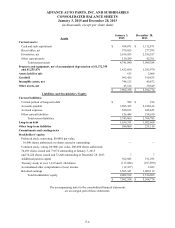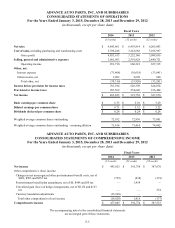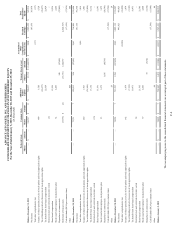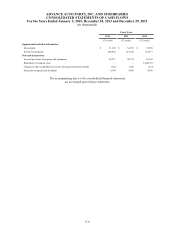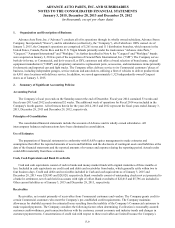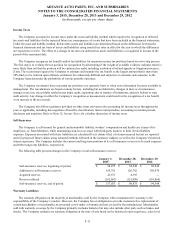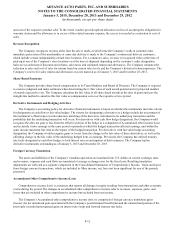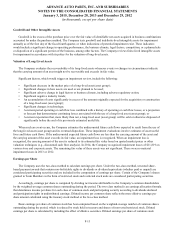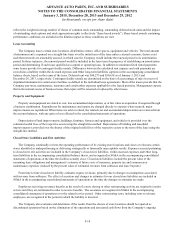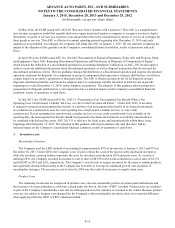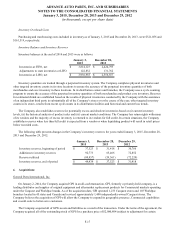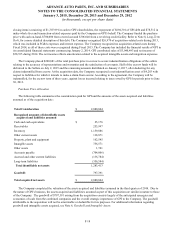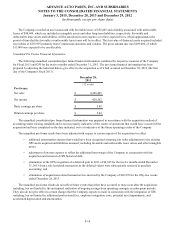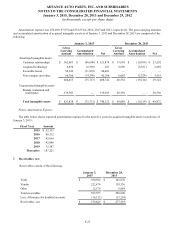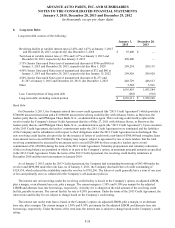Advance Auto Parts 2014 Annual Report Download - page 61
Download and view the complete annual report
Please find page 61 of the 2014 Advance Auto Parts annual report below. You can navigate through the pages in the report by either clicking on the pages listed below, or by using the keyword search tool below to find specific information within the annual report.ADVANCE AUTO PARTS, INC. AND SUBSIDIARIES
NOTES TO THE CONSOLIDATED FINANCIAL STATEMENTS
January 3, 2015, December 28, 2013 and December 29, 2012
(in thousands, except per share data)
F-14
reflects the weighted-average number of shares of common stock outstanding, outstanding deferred stock units and the impact
of outstanding stock options and stock appreciation rights (collectively “share-based awards”). Share-based awards containing
performance conditions are included in the dilution impact as those conditions are met.
Lease Accounting
The Company leases certain store locations, distribution centers, office spaces, equipment and vehicles. The total amount
of minimum rent is expensed on a straight-line basis over the initial term of the lease unless external economic factors exist
such that renewals are reasonably assured, in which case the Company would include the renewal period in its amortization
period. In those instances, the renewal period would be included in the lease term for purposes of establishing an amortization
period and determining if such lease qualified as a capital or operating lease. In addition to minimum fixed rental payments,
some leases provide for contingent facility rentals. Differences between the calculated rent expense and cash payments are
recorded as a liability within the Accrued expenses and Other long-term liabilities captions in the accompanying consolidated
balance sheets, based on the terms of the lease. Deferred rent was $60,275 and $50,638 as of January 3, 2015 and
December 28, 2013, respectively. Contingent facility rentals are determined on the basis of a percentage of sales in excess of
stipulated minimums for certain store facilities as defined in the individual lease agreements. Most of the leases provide that the
Company pay taxes, maintenance, insurance and certain other expenses applicable to the leased premises. Management expects
that in the normal course of business leases that expire will be renewed or replaced by other leases.
Property and Equipment
Property and equipment are stated at cost, less accumulated depreciation, or at fair value at acquisition if acquired through
a business combination. Expenditures for maintenance and repairs are charged directly to expense when incurred; major
improvements are capitalized. When items are sold or retired, the related cost and accumulated depreciation are removed from
the account balances, with any gain or loss reflected in the consolidated statements of operations.
Depreciation of land improvements, buildings, furniture, fixtures and equipment, and vehicles is provided over the
estimated useful lives of the respective assets using the straight-line method. Depreciation of building and leasehold
improvements is provided over the shorter of the original useful lives of the respective assets or the term of the lease using the
straight-line method.
Closed Store Liabilities and Exit Activities
The Company continually reviews the operating performance of its existing store locations and closes or relocates certain
stores identified as underperforming or delivering strategically or financially unacceptable results. Expenses accrued pertaining
to closed store exit activities are included in the Company’s closed store liabilities, within Accrued expenses and Other long-
term liabilities in the accompanying consolidated balance sheets, and recognized in SG&A in the accompanying consolidated
statements of operations at the time the facilities actually close. Closed store liabilities include the present value of the
remaining lease obligations and management’s estimate of future costs of insurance, property tax and common area
maintenance expenses (reduced by the present value of estimated revenues from subleases and lease buyouts).
From time to time closed store liability estimates require revisions, primarily due to changes in assumptions associated
with revenue from subleases. The effect of accretion and changes in estimates for our closed store liabilities are included in
SG&A in the accompanying consolidated statements of operations at the time the changes in estimates are made.
Employees receiving severance benefits as the result of a store closing or other restructuring activity are required to render
service until they are terminated in order to receive benefits. The severance is recognized in SG&A in the accompanying
consolidated statements of operations over the related service period. Other restructuring costs, including costs to relocate
employees, are recognized in the period in which the liability is incurred.
The Company also evaluates and determines if the results from the closure of store locations should be reported as
discontinued operations based on the elimination of the operations and associated cash flows from the Company’s ongoing


